
|
Devon Closewool sheepThe Devon Closewool is a medium sized, white faced, hornless sheep with a dense white fleece of medium length and staple which contributes to its valued quality of hardiness. The wool of the Devon Closewool is ideally suited to the home spinner and also modern manufacturing processes. It should contain no black fiber, and therefore commands a premium price. |

|
Dohne Merino sheepThe Dohne Merino is a synthetic, dual-purpose Merino developed by the South African Department of Agriculture using Peppin-style Merino ewes and German Mutton Merino sires. The progeny were interbred and selected for high fertility, rapid lamb growth rate, and fine Merino wool under commercial rangeland conditions. |
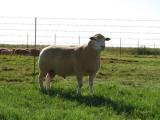
|
Dormer sheepThe Dormer is a cross between Dorset Horn rams and German Merino ewes (presently known as the South African Mutton Merino). It was a direct consequence of a series of extensive slaughter lamb experiments carried out at the Elsenburg Research Station of the Department of Agriculture since 1927 over a period of more than ten years. The name Dormers is an abbreviation of the linkage Dorset-Merino. |

|
Dorper sheepThe Dorper breed is numerically the second largest breed in South Africa. Their popularity has spread to many countries throughout the world, including the United States in 1995. The Dorper was developed in South Africa in the 1930's, through crossing of the Blackheaded Persian ewe (a native fat-tailed sheep) with the Dorset Horn (a mutton breed). |

|
Dorset sheepDorsets are best known for their ability to produce a lamb crop any time during the year. History tells us that centuries ago when Spain wished to conquer England, Merino sheep were brought into southwest England and crossed with the Horned Sheep of Wales. The result was a desirable, all-purpose sheep that spread over Dorset, Somerset, Devon and most of Wales. |

|
Dorset Down sheepThe Dorset Down originated in England around 1800 by mating Southdown rams with the large Hampshire Down, Berkshire and Wiltshire ewes. The Dorset Down is a solid, medium sized, dark-faced, polled sheep. It has a short, close white fleece with wool round the cheeks, between the ears, on the forehead, and down the legs. |

|
Drysdale sheepThe Drysdale is a dual-purpose breed whose wool is used mainly for carpet manufacture. Drysdale sheep carry the dominant Nd gene, a mutant which occurred in the Romney breed. The Nd gene causes a high abundance of coarse, very hairy fibers, called halo-hairs. |

|
East Friesian sheep(Friesian Milk Sheep, Ostfriesisches Milchschaf) The origin of the Friesian sheep breeds is the region of Friesland extending along the North Sea coast westward from the Weser River in the northeast of Germany along the north coast of the Netherlands and south to the Schelde (Scheldt) River at the border of the Netherlands and Belgium. |

|
Easy Care sheepThe guiding principle behind Easy Care is straightforward. Centuries ago, sheep didn't naturally have huge fleeces, merely a winter coat which was shed in springtime, as with most wild animals. However, man began to breed sheep for wool because of its value. In recent times, the value of wool has fallen so dramatically that its production is uneconomic. Meat production without the overhead and extra shepherding required in wool production would be much more profitable. |
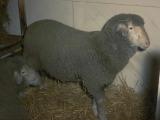
|
Est à Laine Merino sheepAt the end of the 18th century, Merino blood was introduced into German sheep in the borders with France, and gradually these large "meat" Merinos were kept in large numbers in the Alsace Lorraine region of France. This strain became known as the Est à Laine, which translated means East and Wool. |

|
Exmoor Horn sheepThough ancient in origin, the Exmoor Horn, which has existed since time immemorial in the west of England, is well adapted to modern requirements. The Exmoor can be described as a dual purpose breed to keep pure on the higher moorland; in fact, they are classified as a hill breed. |

|
Faeroes sheepThe origins of the Faeroes breed goes back to the Old Norwegian, Icelandic, and perhaps Shetland breeds. They are not gregarious and tend to be territorial. The Faeroes will forage in small groups, spreading to cover the entire area, behaving somewhat like the Icelandic sheep. These sheep are small and well adapted to mountainous terrain. The color varies from white, grey, light red, dark red, chestnut brown, to black. |

|
Finnsheep sheepFinnsheep or Finnish Landrace, as they are known in their native country of Finland are considered to be several hundred years old, descending from the Mouflon that live in the wild on Sardinia and Corsica and also said to be related to other Scandinavian short-tailed sheep. |

|
Gansu Alpine Finewool sheepThe Gansu Alpine Finewool was one of a number of finewool breeds in China which made use of Xinjiang Finewool, along with Russian Merino rams in its development. The Gansu Alpine Finewool was initially based on Mongolian and Tibetan ewes and was developed through backcrossing to Merino type, followed by selection. |

|
German Blackheaded Mutton sheepIn 1850, blackheaded meat breeds, such as Leicester, Southdown, and Hampshire were imported from England into Saxony to be crossed with local breeds. Thirty years later, breeding of these sheep started more in Westfalia and Eastern Prussia than in Saxony. The Merinofleischschaf (Merino mutton sheep) was prevalent in Saxony. |
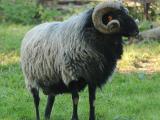
|
German Gray Heath sheepThe German Gray Heath is the symbol of the Lueneburger Heide in Germany. Their ancestors, the Mouflon were at home in Corsica. Single lambs are born in spring with a curly, black fleece. After the sheep’s first yearly shearing, its wool turns silver gray with a black bib. Head and legs are black and free of wool. Rams weigh up to 80 kg (176 lbs) and have imposing horns that curl close to the face. Ewes weigh about 45 kg (100 lbs) and have short horns. |
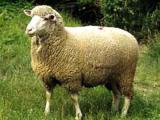
|
German Merino sheepIn the 18th century, Southern German Landsheep were crossed with French and Spanish Merinos, which produced the Merinolandschaf. This sheep breed is the most wide-spread one in Germany today, with 40% of the total German sheep population. The Merinolandschaf of today started with the dual- coated Zaupelschaf, which already in 1539 was not liked because it produced inferior wool. For that reason it was crossed with the Marschschaf from the Lower Rhine. |
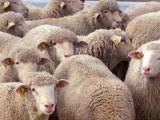
|
German Mutton Merino sheepThere are three German Merino breeds: Merinolandschaf (Merino landsheep), Merinofleischschaf (Merino mutton sheep), and Merinolangwollschaf (Merino longwool sheep). Although all three breeds produce Merino wool and are similar in meat yield, they went through a different historical and genealogical development. The Merinofleischschaf is at home east of the Elbe river, spreading all the way to the Ural Mountains. |

|
German Whiteheaded Mutton sheepThis breed was developed along the North Sea coast in the middle of the last century. English Leicester, Cotswold, Hampshire, and Oxfordshire were imported and crossbred with the local Wilstermarschschaf, a northern German marsh sheep. Breeders succeeded in retaining the wanted qualities of the marsh sheep, such as high fecundity, fast development, and large size. In the 1930’s, a new breed, the Deutsches Weißköpfiges Fleischschaf started to roam the grassy areas next to the North Sea. |

|
Gotland sheepGotland sheep were first established on the large Baltic island of Gotland, off the east coast of Sweden. The Vikings brought Karakul and Romanov sheep back from Russia and crossed them with native landrace sheep, such as the Gute. Gotlands are polled. They have short, hair-tipped tails and do not require crutching. |

|
Greyface Dartmoor sheepThe Greyface Dartmoor is also known as the Dartmoor or "Improved" Dartmoor. Descended from the local breeds, which grazed the low ground in and around Dartmoor, they have immense strength of constitution developed through withstanding the severe winters and exposed conditions, which exist around the Moor. Improvements were carried out during the 19th century using the local Longwools (Notts) and the Leicester. |
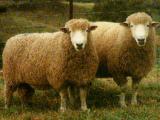
|
Growmark sheepDevelopment of the Gromark began in 1965 in northern New South Wales, Australia. The Gromark is fixed at approximately 50 percent Corriedale and 50 percent Border Leicester. It is a dual-purpose sheep which evolved from objective selection for high growth rate and fertility with final selection being based on visual criteria: wool quality, frame, and carcass attributes. |

|
Gulf Coast Native sheepSpanish sheep first arrived in Florida in the 1500's. Later importations of Spanish and other breeds of sheep mixed with the earlier population, all evolving under the strong natural selection of the native range conditions of Florida and the other Gulf Coast states. Today a remnant of this population survives and is known as the Gulf Coast. |

|
Gute sheepGute sheep are the most primitive breed in the collection of breeds that make up the Swedish Landrace breed group. These breeds belong to the North European Short Tailed Breeds and are related to such breeds as the Finnsheep, Romanov, Spelsau, Shetland, Faroe, Orkney, and Icelandic sheep. |

|
Hampshire sheepThe Hampshire sheep acquired its name from the agricultural county of Hampshire in southern England where it was developed from Old Hampshire, Southdown, Wiltshire Horn, and Berkshire Knot crosses. Hampshires were first brought to the United States in 1860, but all of the flocks were either destroyed or scattered during the Civil War. |

|
Han sheepThe Han is a type of Mongolian sheep. It was developed in the semi-humid agricultural areas of China (Henan, Hebei, Shandong, Anhui and Jiangsu Provinces). There are two types of Han which in 1982, were claimed as two different breeds: Large-tail Han and Small-tail Han. The Large-tail Han are polled and are characterized by a long, broad, fat tail, with a thin twisted end turing upwards between two lobes, and broadest at the base. Maximum weight being 25 kg. |

|
Hebridean sheepThe Hebridean, a sheep breed now classified as rare, originated in the islands off the western coast of Scotland. They are classified as one of the Northern Short-tailed breeds. Over the centuries, Hebridean ewes have been selected by natural systems for hardiness in all weathers, ease of lambing, milkiness and good mothering instincts. |

|
Heidschnucke sheepThe Heidschnucke are a fairly small sheep, initially originating from Niedersachsen in Germany. There are several varieties of Heidschnucke sheep: the grey horned Heidschnucke, the white horned Heidschnucke, and the moorschnucke (marsh sheep). At one time, the Heidschnucke were the most important sheep in northern Germany, but their numbers have declined substantially. |

|
Herdwick sheepThey name Herwick is derived from an old Norse word that means sheep pasture. It is believed that the ancestors of Herdwick sheep were introduced by early Norse settlers. Herdwick sheep are considered the most hardy of British hill sheep. |
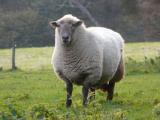
|
Hill Radnor sheepThe Hill Radnor is a hardy hill sheep with a long history attached to the central marshes of Wales. |
| 1 | 2 | 3 | 4 | 5 | 6 | 7 | 8 |